You are currently browsing the tag archive for the ‘circus’ tag.

Labor Day is over. Another summer is dying away. I wanted to celebrate the summer (it is my favorite season!) without giving into the elegiac feelings of fall, so I drew this sunset drawing of merriment in Central Park. As always my muse is the incomparable Lillian Newberg, doyenne of the resurrected New York roller disco scene (would that I could participate–but I can no more dance…or walk…or stand still…on roller skates than I can fly like Superman). Around her are strange & mysterious circus folk with hotdogs and ice cream, while a rather splendid toucan preens at the treeline. The sloth is not a roller skater either, but at least he can drag himself to the party on a skateboard. A langur turns the magical disco jack-in-the-box, while various angelic folk fly around the heavens as per their wont. The scene is delightful except for the tragic sentient lemon and the rubber chicken (which has been accidentally discharged from a novelty cannon). The snake represents moral choice whereas the flounder suggests that our appetites will always be lurking in the immediate foreground of anything we do. I don’t know what is up with that fancy garter belt. Somebody probably dropped it there by accident and it has nothing to do with the larger parable…
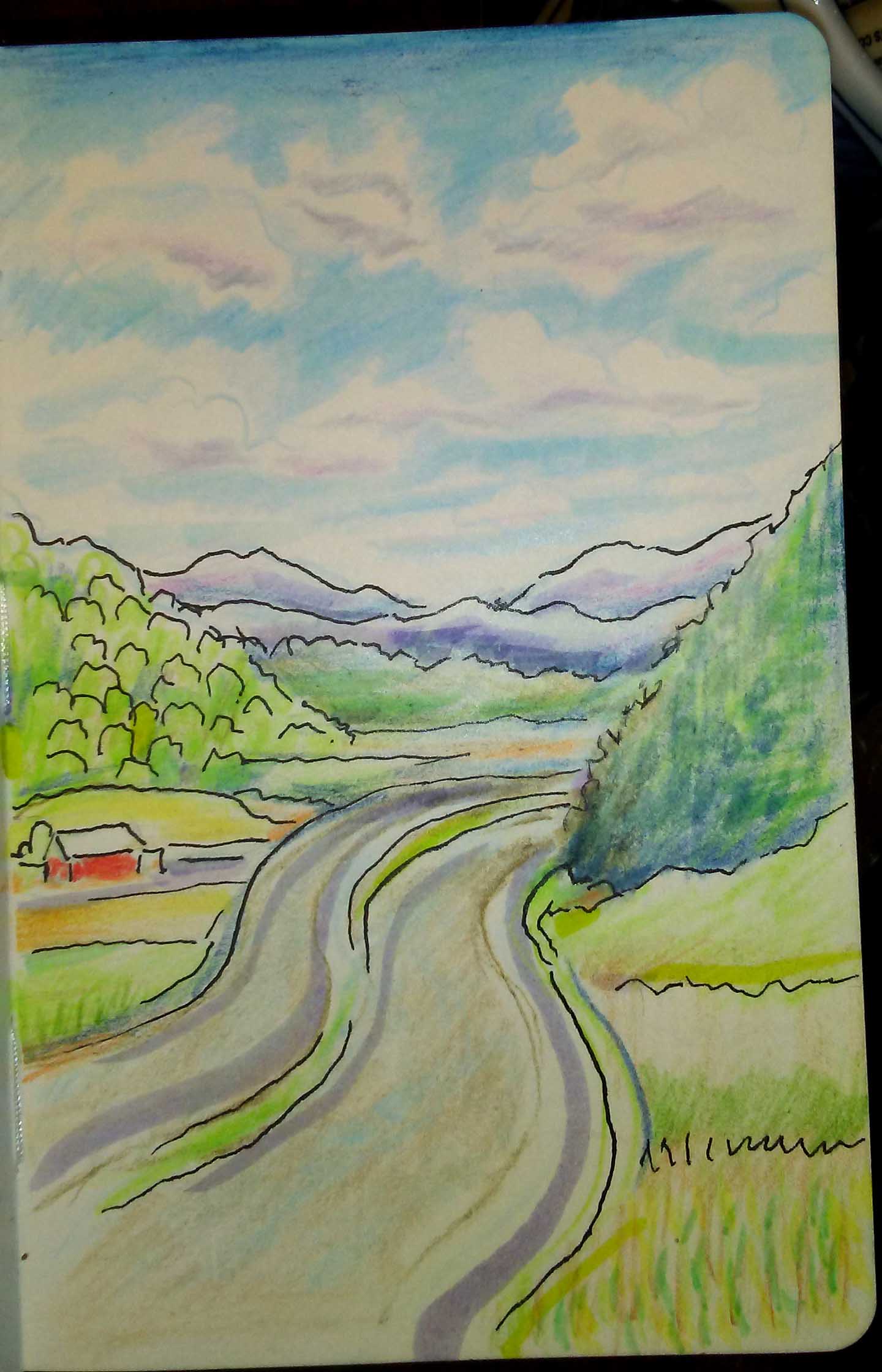
I am back from the bosky hills and verdant dells of West Virginia and SE Ohio and I have a lot of new ideas and stories to share. Thanks Mom and Dad for the lovely visit and all of your kindness. Also, I want to thank Dan Claymore who did a superb job in my absence. Dan understood the purpose of Ferrebeekeeper and matched the tone beautifully (although that Japanese fishmarket made me anxious for the oceans and our flatfish friends). Because of his excellent work, I realize I should take more vacations. Dan also confided in me that he found the project intimidating because of the perspicacity of the polymath readers…so, as always, thank YOU!
When I travel, I carry a little book and a tin of pens and colored pencils (my tin is shaped like a sarcophagus and is interesting in its own right, but more about that later). I like to quickly draw little colored sketches of what pops into my head or what is in front of me. Sometimes there are realistic. Sometimes they are utterly fanciful. They are sometimes silly and occasionally sad. I have dozens of volumes of New York drawings, but I figured I should share all the little sketches I made on my trip (unfortunately nobody posed for me–so there are no portraits). Keep in mind that these are sketches–so they are quick and imperfect. For example, I drew the one at the top in the car as my family and I went to a wedding in the central mountains of West Virginia, and half way through I realized I didn’t have a dark gray pencil. Roads are hard for me too (as are straight lines in the moving car). Maybe this says something about the unnatural yet astonishing nature of our highway infrastructure.

In the car, I also drew this humorous drawing of a gnome kingdom. My mother was describing a nuclear weapons facility somewhere which she visited during her Pentagon career, and I apparently misheard the name. This delightful misunderstanding engendered a whole didactic gnome world. Fribble Fribble!
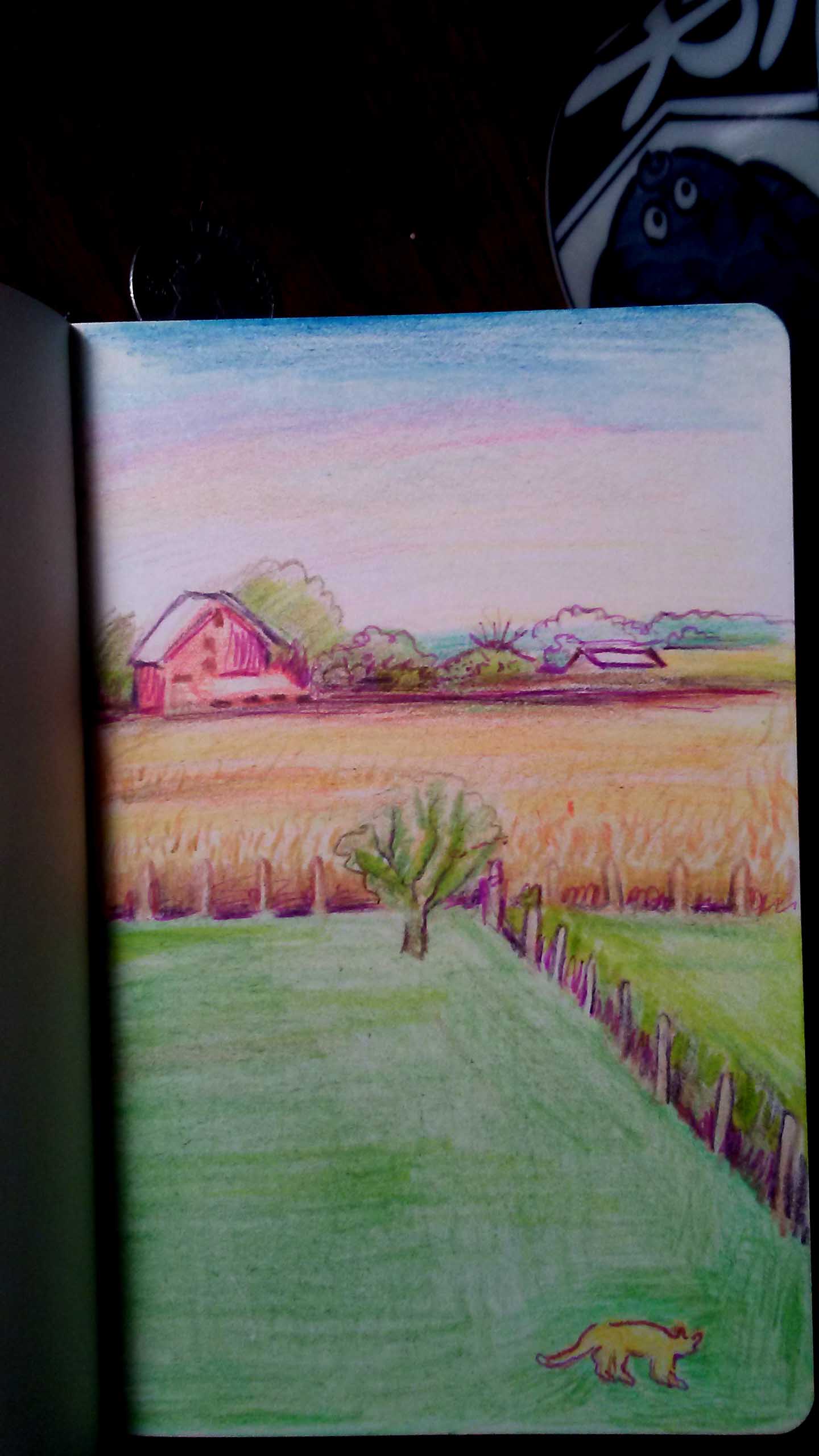
This drawing is the corner of the yard at home with autumn cornfields beyond. Vinnie the barncat is sneaking onto the right corner, catty-corner from the old Amish farmstead. I wish I could have captured Vinnie better, but Rory the obstreperous adolescent poodle chased him off, before I could catch a better likeness.

No Ferrebeekeeper sketch collection would be complete without a magical flounder. This one apparently has a direct connection to the underworld. More about that in later posts.
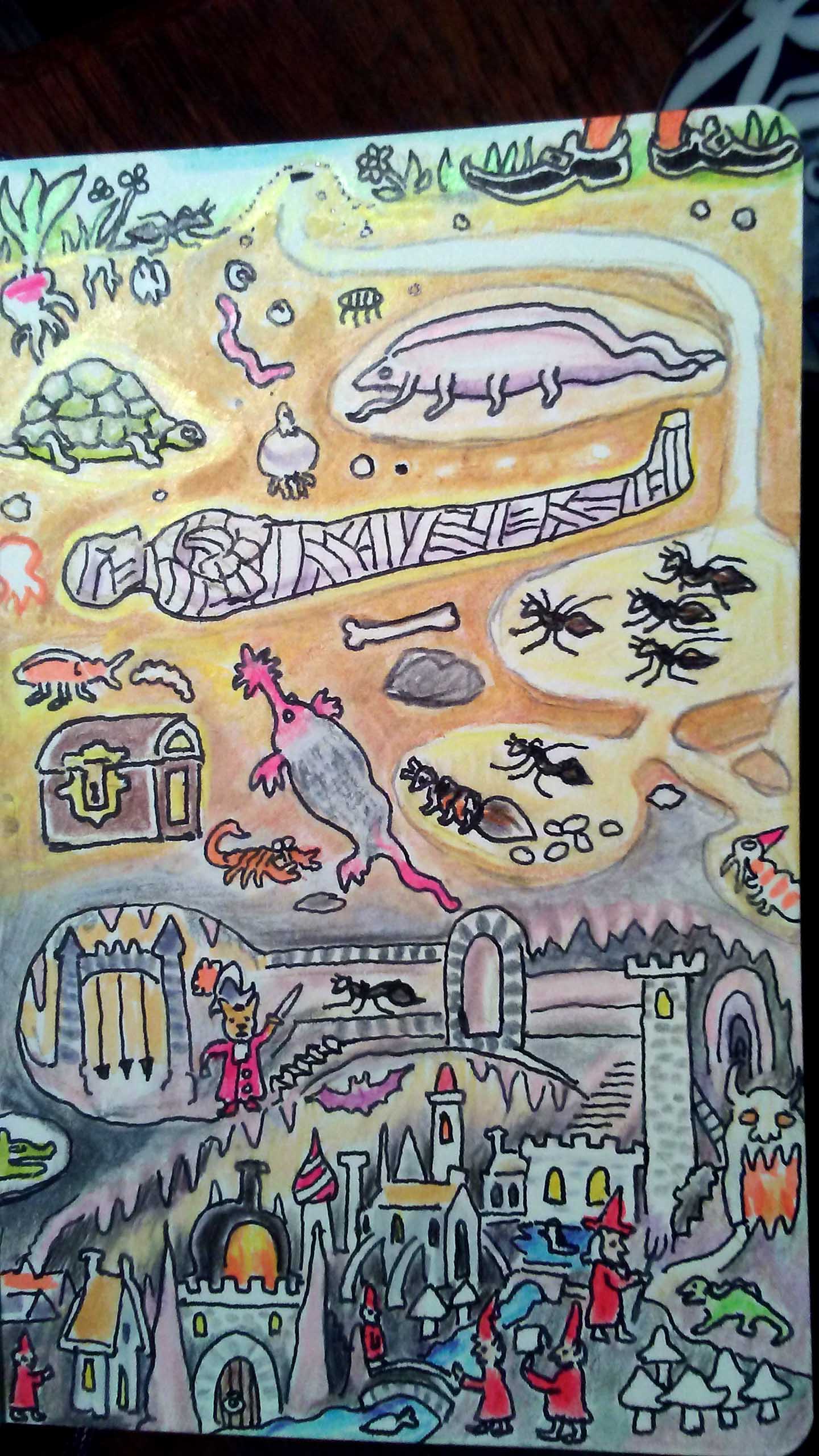
Speaking of the underworld, here is a little drawing of the world beneath the topsoil. There is a lungfish, a brumating turtle, a mole, a mummy, and an ant colony, but beneath these ordinary items is a whole gnome kingdom. Don’t worry! I don’t believe in gnomes. Their tireless tiny civilization really represents bacteria to me…oh and humans civilization too (artistic allegory is more of an art than a science). This macro/micro dichotomy is captured by the shoes of a full sized (albeit anachronistic) human at the top left.
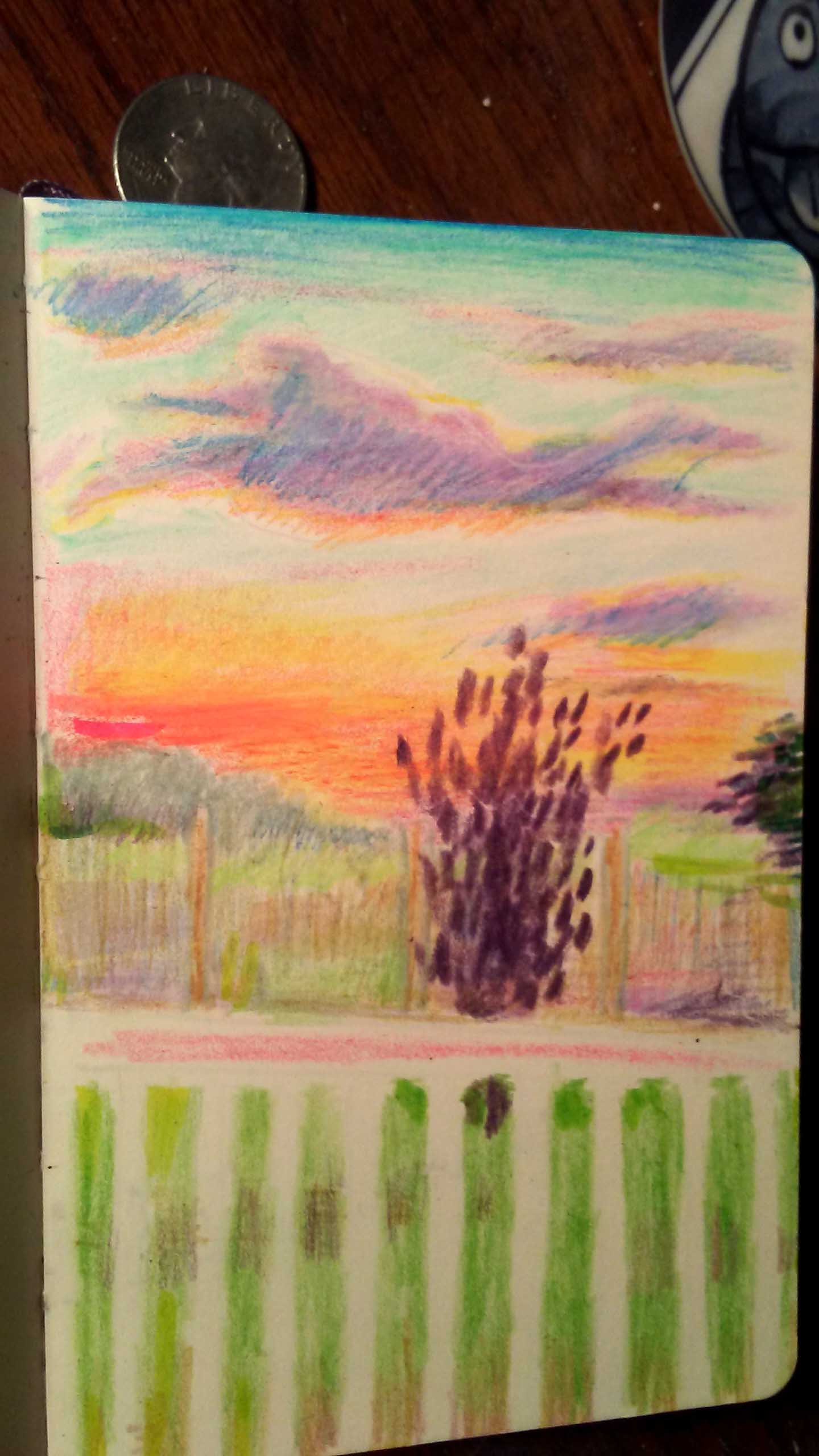
This is a quick impression of a sunset which was SO beautiful. If only I could truly have captured more of its sublime luminescent color….
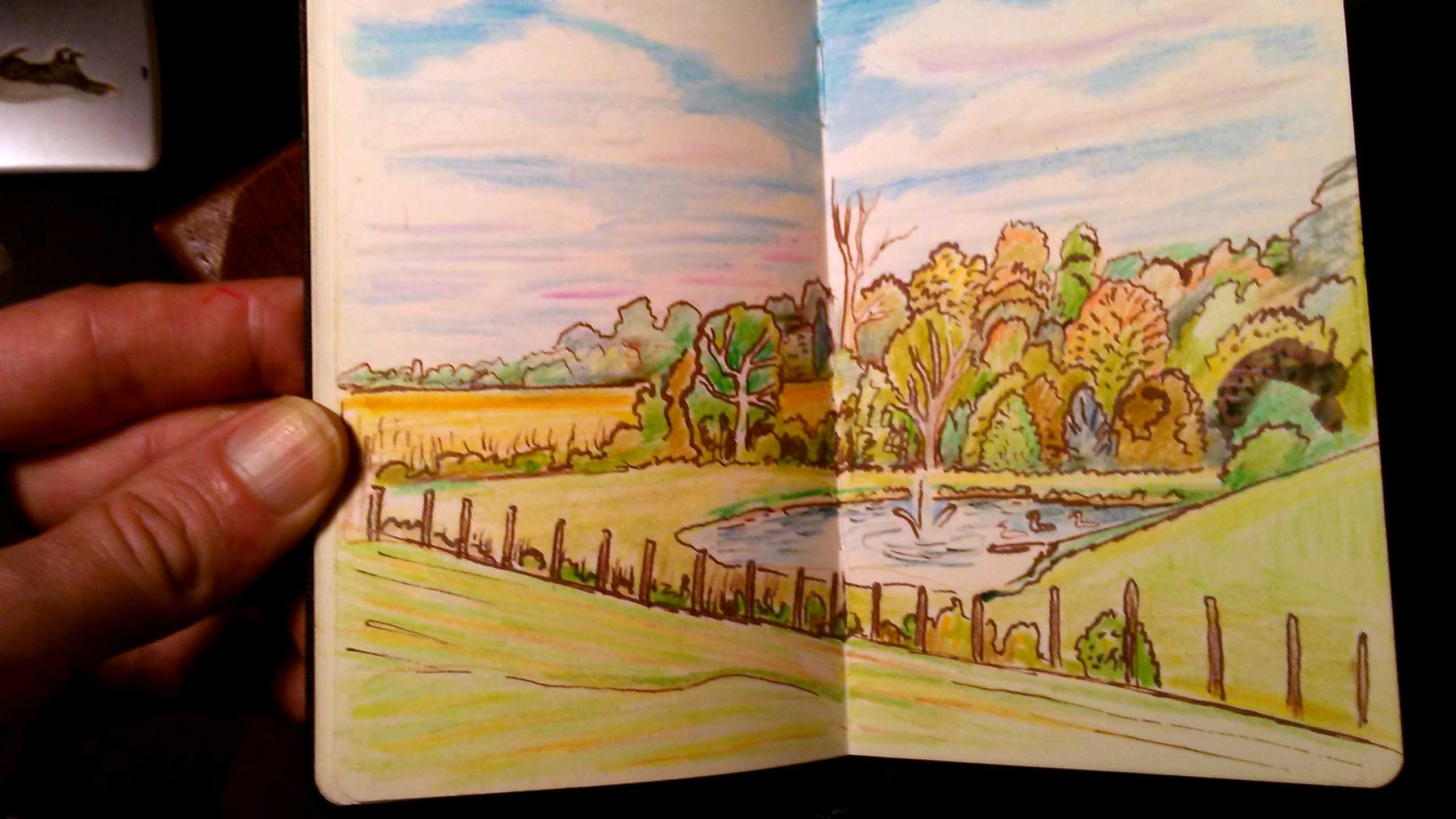
This is my parents’ pond, which I love more than I can tell you. Unfortunately a big drip came out of my dip pen and made the ducks look monstrous. There is a hint of autumn orange in the trees. This is another one that frustrates me, because reality was so pretty.
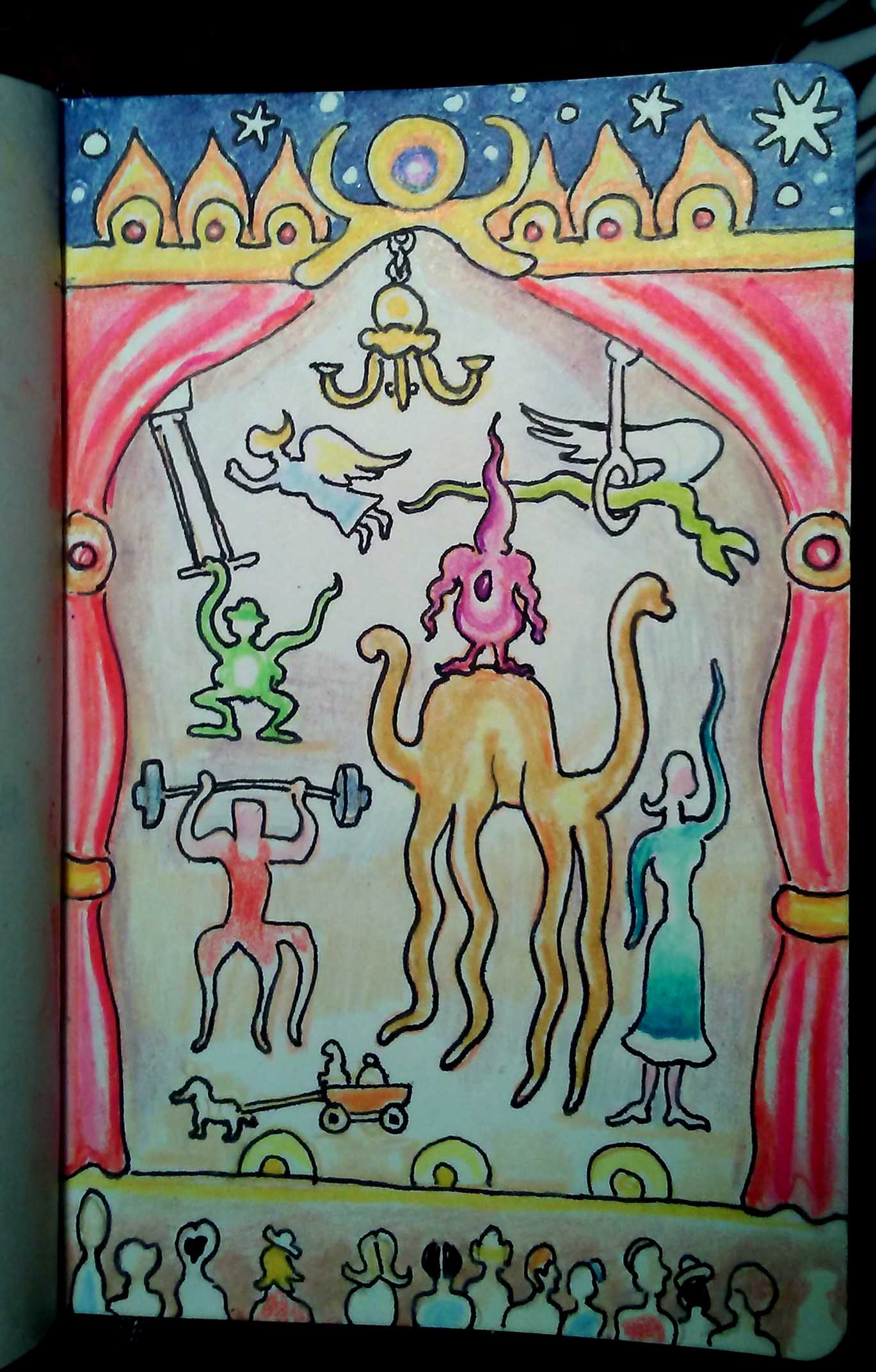
I watched the second half of a documentary about the circus on PBS. It seems like the circus was more important and central to our nation than I knew (although I should have guessed based on current politics). I represented the performers as abstract shapes, but the overall composition bears a debt to Cimabue and his Byzantine predecessors.

Finally here is a picture from the tarmac of John Glenn airport in Columbus. Naturally the plane moved away as soon as things began to get good. By the way I really enjoyed my flight and I am always surprised that people are so angry about flying. For the price of a moderately fancy dinner, we can rocket across the continent above the clouds at hundred miles an hour. We travel like the gods of Greek mythology except people serve us coffee and ginger cookies and, best of all we can truly see the earth from a towering perspective–which is the subject of my last picture which I scrawled as we looped back across Long island west to LaGuardia (I’m glad I am not an air traffic controller). Sadly this picture did not capture the beauty and complexity of Long Island Sound, and Queens (nor even the lovely billowing cumulus clouds) but at least it made me stare raptly out the window at the ineffable but disturbing beauty of the strange concrete ecosystem we are building.
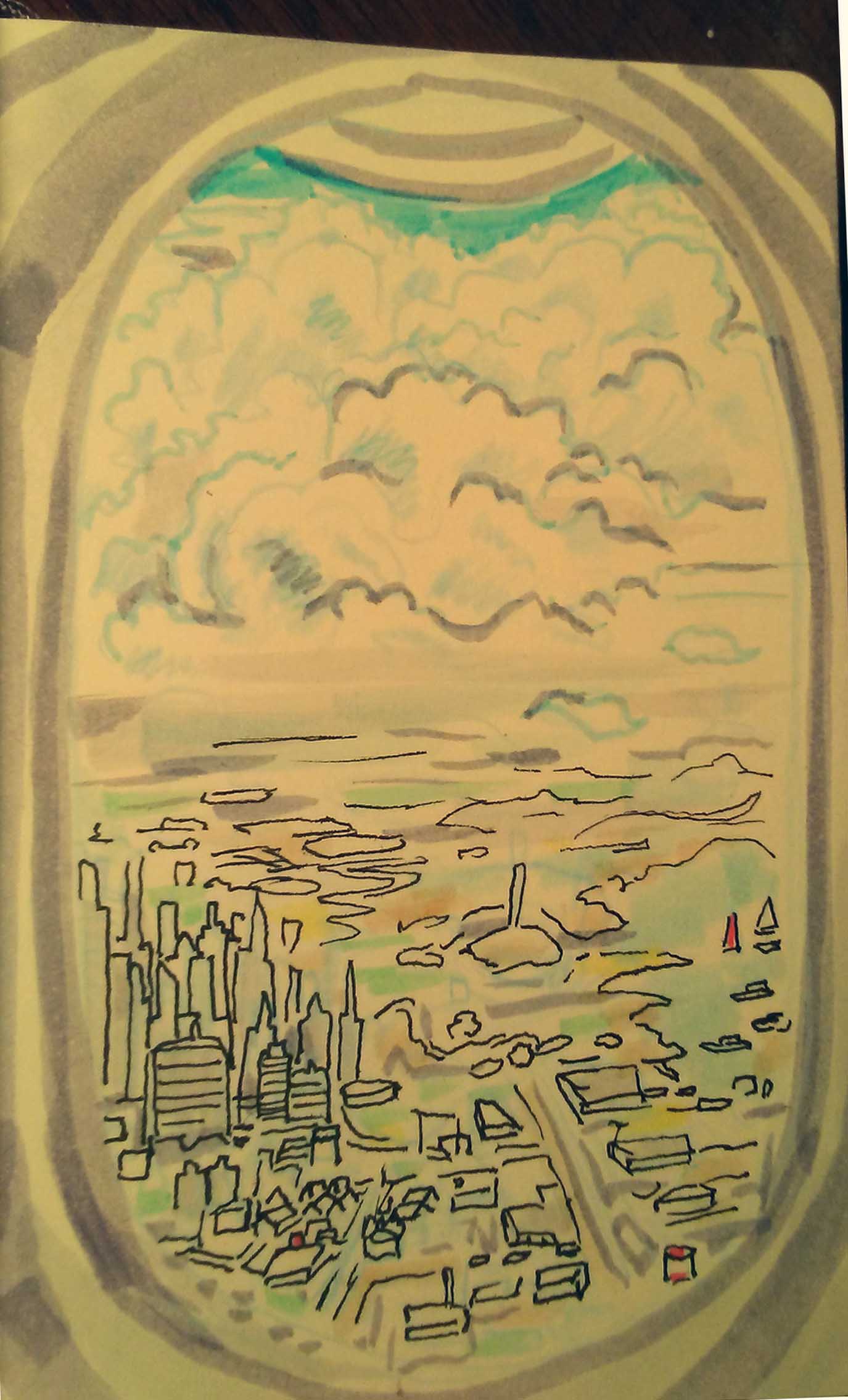
Let me know what you think of my little sketches and, now that summer vacation is out of the way, get ready for some October horror and Halloween fun! Oh! Also get ready for Dan Claymore’s book about a human gumshoe in the dark robot future. It will be out before you know it, and it is going to be amazing!
The Magic Circus is a bizarre contemporary gothic painting created in 2001 by Mark Ryden, the king of the pop surrealist painters. Ryden was born in the Pacific Northwest and grew up in Southern California. At the beginning of his career, he was a commercial artist who created magazine illustrations, book covers, and album covers, but due to the outlandish visionary intensity of his work, he has successfully broken into the rarified top echelon of contemporary painters. His works have sold very successfully for over a decade (although he is regarded as a bizarre outsider by the unofficial “academy” of curators and critics).
The Magic Circus is an eye popping juxtaposition of cartoonlike hybrid animal/toy characters, science book illustrations, and delicate vulnerable children. The upbeat but sinister pastel circus landscape has been rendered with the precise and exacting realism of the finest illustration. As with 16th century Flemish art, dark horrors lurk among the details. Looking past the dazzling crown and jewel-like bees and cheery dancing octopus, the viewer notices a striped winged demon with a shrunken head drinking a chalice of blood. Jesus and Abraham Lincoln are rendered as toys and lifeless sculptures while a plush stuffed animal capers in the foreground with lively malice.
Many of Ryden’s works involve the idea that our icons and consumer goods are springing to malevolent life and taking over. The Magic Circus has the visceral appeal of a child’s nightmare. The toys are coming to life and putting on a show, but there is a dark and horrible side to the carnival. Within the interlocking “rings” of childlike delight, scientific materialism, and commercial exploitation, Ryden includes symbols and themes which he reuses again and again in his paintings.
Pop Surrealism takes kitsch elements from everyday life and arranges them in a way to maximize the emotional, sentimental, and psychological aspects of everyday symbols. The narrative focus, realistic technique, and psychological intensity of this diffuse school have all been disparaged by “high-brow” art schools and abstract/conceptual artists for the past few decades. Yet as the visual language of the internet becomes more pervasive (and as mainstream art languishes in a conceptual rut), Pop Surrealism has been finding broader acceptance
Since the moon is the closest celestial body to earth and the most easily observed with a telescope, it was a natural place for Herschel to begin his search for extraterrestrials. In a letter to a friend, Herschel described how he believed the craters of the moon were Lunarian cities and dwellings (laid out like the Roman “circus” meaning a large ring):
As upon the Earth several Alterations have been, and are daily, made of a size sufficient to be seen by the inhabitants of the Moon, such as building Towns, cutting canals for Navigation, making turnpike roads &c: may we not expect something of a similar Nature on the Moon? – There is a reason to be assigned for circular-Buildings on the Moon, which is that, as the Atmosphere there is much rarer than ours and of consequence not so capable of refracting and (by means of clouds shining therein) reflecting the light of the sun, it is natural enough to suppose that a Circus will remedy this deficiency, For in that shape of Building one half will have the directed light and the other half the reflected light of the Sun. Perhaps, then on the Moon every town is one very large Circus?…Should this be true ought we not to watch the erection of any new small Circus as the Lunarians may the Building of a new Town on the Earth….By reflecting a little on the subject I am almost convinced that those numberless small Circuses we see on the Moon are the works of the Lunarians and may be called their Towns….Now if we could discover any new erection it is evident an exact list of those Towns that are already built will be necessary. But this is no easy undertaking to make out, and will require the observation of many a careful Astronomer and the most capital Instruments that can be had. However this is what I will begin.
Of course this spectacular misapprehension becomes more comprehensible considering how long it took humanity to understand the nature of craters (it wasn’t until the 1960’s that work by astrogeologist Gene Shoemaker, brought about widespread scientific consensus that craters were caused by impacts). Yet Herschel was so devoted to his Lunarians that he came perilously close to inventing findings. As he carefully scrutinized the moon for other living things night after night, imperfect optics and his yearning for alien life sometimes got the best of him. Here is a drawing of a shadow which he perceived might be a forest.
Herschel did not believe that the moon was the only other sphere to support life–he believed that life could be found on all heavenly bodies which are spherical from self-gravitation. And Herschel really meant all such bodies: in the Royal Society’s Philosophical Transactions in 1795 he speculated about beings living on the sun,
The sun…appears to be nothing else than a very eminent, large, and lucid planet, evidently the first, or in strictness of speaking, the only primary one of our system….Its similarity to the other globes of the solar system …leads us to suppose that it is most probably inhabited …by beings whose organs are adapted to the peculiar circumstances of that vast globe.
Hershel thought that all of the stars in the universe were like the sun—densely habited and supporting an orbiting network of habited worlds. He wrote “since stars appear to be suns, and suns, according to the common opinion, are bodies that serve to enlighten, warm, and sustain a system of planets, we may have an idea of numberless globes that serve for the habitation of living creatures.” Additionally, Herschel believed that the nebula he observed were other “universes” like our own, each containing innumerable stars—all of which were habited. He was wrong in his interpretation of the particular gaseous nebulae he was looking at, but he was quite right about the existence and nature of other galaxies (although this idea was not proved or accepted until the work of Edwin Hubble).
Poor Herschel’s hunches about extraterrestrial life seem quaint to us now. Couched in boyish exuberance and 18th century idioms, they almost seem risible. Yet Herschel was right about exoplanets and about galaxies beyond our own. He seems to have been the only person of his time to begin to apprehend how vast the universe really is. Thanks to the work of many scientists and explorers we can write off life on the moon and (almost certainly) the sun. However, even with our robot probes and our telescopes, the solar system is shockingly unknown. And beyond the solar system, the large exoplanets we currently know about are strange hot giants we did not expect. The preliminary results of the Kepler mission are beginning to trickle in, and they hint at a profusion of planets (and other things) much more heterogeneous and odd than cosmic uniformitarians might expect. If blogging has taught me one thing, it is not to underestimate Sir Frederick William Herschel (a conclusion I hardly anticipated). So while I chuckle about the perfectly circular cities of the lunarians, I am also keeping an open mind about the immense number of unknown worlds.
Also (as I suspect Sir William felt), I am sad about how many things are simply unknowable.






